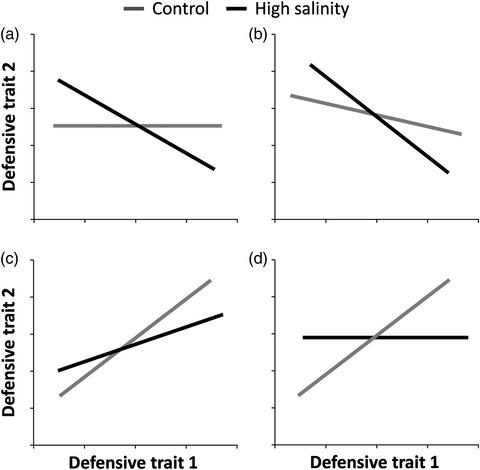Our official English website, www.x-mol.net, welcomes your
feedback! (Note: you will need to create a separate account there.)
Effects of soil salinity on the expression of direct and indirect defences in wild cotton Gossypium hirsutum
Journal of Ecology ( IF 5.3 ) Pub Date : 2020-07-31 , DOI: 10.1111/1365-2745.13483 Teresa Quijano‐Medina 1 , Ted C. J. Turlings 2 , Paula Sosenski 3 , Luca Grandi 2 , José C. Cervera 1 , Xoaquín Moreira 4 , Luis Abdala‐Roberts 1
中文翻译:

土壤盐分对野生棉陆地棉直接和间接防御表达的影响
更新日期:2020-07-31
Journal of Ecology ( IF 5.3 ) Pub Date : 2020-07-31 , DOI: 10.1111/1365-2745.13483 Teresa Quijano‐Medina 1 , Ted C. J. Turlings 2 , Paula Sosenski 3 , Luca Grandi 2 , José C. Cervera 1 , Xoaquín Moreira 4 , Luis Abdala‐Roberts 1
Affiliation

|
- Previous studies have frequently reported effects of abiotic factors on herbivore‐induced plant defences based on effects on single plant traits. However, plants commonly express multiple defences simultaneously and these traits are often correlated. Thus, a fuller understanding of abiotic‐context dependency in plant defence requires measuring multiple traits and addressing their patterns of correlated expression.
- We evaluated the effects of soil salinity on the expression of direct (phenolic compounds, gossypol gland density) and indirect (volatile organic compounds, extrafloral nectar) defensive traits in wild cotton Gossypium hirsutum. Specifically, we asked whether soil salinity affects the induction of these traits, and whether it shapes trait correlations potentially underlying altered patterns of trait induction. We conducted a factorial experiment with 16 cotton genotypes where we manipulated soil salinity and defence induction by applying artificial leaf damage (25% mechanical damage and caterpillar oral secretions) and measured defence levels at different time points post damage.
- Leaf damage induced most traits except gossypol gland density, whereas salinity did not have a mean effect (across constitutive and induced levels) on any of the measured traits. Nonetheless, salinity prevented the induction of phenolic compounds (condensed and hydrolysable tannins), and also affected trait correlations. Specifically, phenolic compounds were negatively associated with nectar production only under salinized conditions, an apparent trade‐off that could affect the induction of phenolic compounds. In addition, positive correlations between phenolic compounds and gland density and root biomass observed under control conditions were lost under salinized conditions.
- Synthesis. By investigating the effects of soil salinity on the expression of multiple direct and indirect defensive traits and their underlying correlations, these findings build towards a better understanding of how abiotic context dependency shapes plant allocation to and expression of multiple defensive traits.
中文翻译:

土壤盐分对野生棉陆地棉直接和间接防御表达的影响
- 以前的研究经常基于对单株植物性状的影响,经常报告非生物因子对草食动物诱导的植物防御的影响。然而,植物通常同时表达多种防御,而这些性状通常是相关的。因此,要对植物防御中的非生物环境依赖性有更全面的了解,就需要测量多个性状并解决其相关表达模式。
- 我们评估了土壤盐分对野生棉陆地棉中直接(酚类化合物,棉酚腺密度)和间接(挥发性有机化合物,花外花蜜)防御性状表达的影响。具体而言,我们询问土壤盐分是否会影响这些性状的诱导,以及是否会影响潜在地改变性状诱导模式的性状相关性。我们对16种棉花基因型进行了析因实验,我们通过施加人工叶片损伤(25%机械损伤和毛毛虫口腔分泌物)来操纵土壤盐分和防御诱导,并在损伤后的不同时间点测量防御水平。
- 除棉酚腺密度外,叶片损伤诱导了大多数性状,而盐分对任何测得的性状均无平均影响(在组成和诱导水平上)。然而,盐度阻止了酚类化合物(缩合和可水解的单宁酸)的诱导,并且还影响了性状的相关性。特别是,仅在盐碱化的条件下,酚类化合物才与花蜜产生负相关,这种明显的权衡可能会影响酚类化合物的诱导。另外,在盐渍化条件下,在对照条件下观察到的酚类化合物与腺体密度和根生物量之间的正相关性消失了。
- 综合。通过研究土壤盐分对多种直接和间接防御性状及其相关性表达的影响,这些发现有助于更好地理解非生物环境依赖性如何影响植物对多种防御性状的分配和表达。











































 京公网安备 11010802027423号
京公网安备 11010802027423号